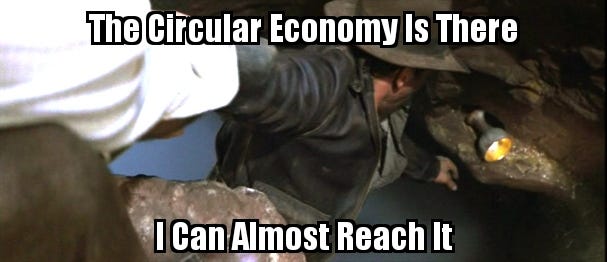Circular Economy Of My Dreams or Is It Just Green Washing?
Circular Economy and Green Chemistry April Issue
This is the question I ask myself whenever I collect links and stories for this issue of the newsletter. I try not to get ensnared by what I might view as green washing. Also, I’m getting into the meme game.
There is a lot of positive news out there with respect to sustainable materials and how our supply chains have the opportunity to become circular. Chemical companies and consumer packaged goods companies (CPGs) want you to pay attention to their sustainability efforts. It’s good marketing.
If you have been following the space for the last twenty years everything seems to have been just out of reach. We almost had chemical recycling of plastics in the 1990s and now its back is a good example. Typically, new green technologies promise to unlock the future of our dreams. Examples might include polyhydroxyalkanoates being degradable in marine environments, biofuels replacing gasoline, or carbon capture technologies making fossil fuel power generation cleaner. If we can get these technologies to work then our green economy dreams could come true. Absolution.
The typical story goes something like this:
Promising new technology is developed at a university and a company is formed
Company raises private money while promising a bright future if they are successful
R&D work happens for 5-10 years with more rounds of funding being raised
Company goes public with their first product
Company eventually attempts to pivot when economics of the product do not work. Layoffs start.
Company goes bankrupt, lays off more employees, maybe a small cohort stay to try and make the pivot idea viable. Company maybe gets acquired by a larger company for IP portfolio.
Rinse and repeat
There are also stories about how once promising technologies have resulted in bankruptcies or certain companies being investigated for fraud. How do we predict companies and technologies that might succeed where others have failed?
One thing that I look for is alignment of the article or press release I am reading to my perception of what is possible in reality now or even possible in the lab. This story from March in Biocycle by Nora Goldstein is a good example of staying consistent with what I believe to be reality. In the article Nora writes about how she attended a recent conference discussing policy, labeling, and standardization of compostable packaging. The conference was trying to figure out the barriers to developing a composting economy by engaging the composting processors (radicals and their ideas).
Essentially, she found that compostable packaging helps generate more food scrap composting while non-compostable materials in the waste stream hinder composting efforts. If you have never been to a hawker market in Singapore check out the scene above from Crazy Rich Asians. Lots of small dishes served on portable single use plates or containers. This is a prime opportunity for compostable plastic materials and could be an excellent opportunity for Singapore to generate more compost and less trash. Think about finishing off a chili crab and then knowing that the plate the crab was served on is also going to get composted and used to grow more chilies for the next chili crab. We could apply the same thing to our food courts here in the US.
Goldstein writes that an acceptable standardization of composting is still a problem (backyard vs industrial), but less restricting of a problem than organic agriculture standards that can exclude some end market applications of compost. Compost producers are the axle that circular compostable economies and complete the virtuous cycle for a waste to field cycle. If the economic viability of being a composter is difficult then our circular economy dreams will never take flight. The problems Nora Goldstein writes about seems mundane and this is why I find it to be a more realistic version of reality when it comes to circular economies.
Another recent development I saw was Ford and HP have joined forces to try and turn 3D printing waste into injection molded fuel-line clips. This announcement from Ford might seem maddeningly trivial because these new parts made from 3D printing waste are 7% lighter and cost 10% less than conventional fuel line clips. Ford’s sustainable materials team is headed up by Debbie Mielewski and she has been working on these materials for years. The progress she has reported from what I’ve kept up with when I used to attend conferences has been incremental and slow because there is typically no “silver bullet” technology when it comes to implementing new sustainable materials. If we get enough 7-25% sustainability options at scale on multiple parts then we are starting to talk about tons of material as opposed to pounds. Any time there is a claim by a company proclaiming anything resembling a “silver bullet” indicates someone who either does not understand the chemical industry or does not understand the difficulty in scaling a new technology. Those who proclaim they got 7-20% recycled material improvements in their products know how hard it was to get the 7-20% in the first place and once again aligns with my sense of reality.
Memorandums of Understanding and investments into technology are good half measures because it allows cash rich companies to externalize R&D risks to their supply chain or start-ups. I think shareholders would rather see their cash deployed to potential equity opportunities and supply chain advantages than to internal R&D projects that are often more incremental and less risk averse (see Ford above). I believe shareholders prefer defined investments as opposed to quarterly overhead creep, at least in my experience (maybe this is a topic for a different newsletter).
This is how companies like Avantium are selling the capacity of their new plant in the Netherlands before it is even finished being built and they recently announced that they have commitments for >50% of the potential volume. A good example of this was Estee Lauder Companies’ memorandum of understanding with Eastman on buying sustainable resins for their packaging. Unilever invested $15 million with Closed Loop Partners, a venture capital fund to develop new closed loop technologies. These announcements do not mean that new sustainable packaging has been achieved or that we have solved any problems, but they are signals that these companies take the issue seriously and are looking for any options that will provide absolution.
Closed Loop Partners could take the Unilever money and get in on the next round of funding for Cemtiva who is looking to turn carbon dioxide into ethylene by growing engineered algae. Cemtiva recently secured investment from Oxy Low Carbon Ventures (VC arm of Occidental Petroleum) to build a 1 ton/month production facility to demonstrate the technology. I am typically skeptical of biomanufacturing of industrial chemicals because yields and downstream processing can be a real challenge that never gets solved. Companies like Metabolix (now Yield10), Bioamber, Solazyme (now TerraVia) all raised enormous amounts of money to build technologies that never really had the initial impact they had promised. However, if Cemtiva can demonstrate a CO2 to ethylene process that is cost competitive with ethylene from oil then I could be a believer primarily because the separation of ethylene from an algae tank seems straight forward. Extracting a valuable oil from a algae tank or fermentation broth seems more difficult. This is when I wish I had taken a separations class or why it’s good to have a chemical engineer around.
The problem of green washing is that it makes things more difficult for companies and researchers actually trying to solve problems. Ben Elgin wrote for Bloomberg that The Nature Conservancy is investigating itself for dubious carbon offset credits. What is a carbon offset credit you ask? It is essentially exchanging money in order for an NGO or non-profit like the Audubon Society to sequester a ton of green house gas emissions through through land conservation.
Rules around carbon offsets are lax right now. Offsets can be declared for land that was never intended to be harvested for lumber or developed. In a sense if you are a large corporation buying carbon offsets there is a chance that those offsets were never actually effective. If this seems criminal or wrong in some ways I would point towards the financial crisis. The rules are lax so in a sense no one did anything against the rules despite moral ambiguity. The idea that a corporation or a person could just offset their carbon footprint with money sounds too good to be true when you think about it.
If corporations were serious about doing carbon offsets they would probably be better off setting up their own NGO or non-profit, buying land, and then developing that land into a permaculture oasis. Corporations could just buy fallow land and even rent it out to would be permaculture farmers. A good model to follow for these corporations would be Doug Tompkins, the co-founder of The North Face who ended up selling his shares of his company to go build a nature conservancy in Patagonia.
The risk we run with the current state of carbon offsets is it being considered green washing. The dubious nature of what is happening around carbon offsets as reported reduces the overall effectiveness of the organizations that are fighting for the very environmental causes they are championing. Green washing makes it more difficult for companies and products that are designed to usher in a the circular economy of the future.
Remember, if the green technology you are reading about sounds too good to be true it might be. If you are curious about anything related to green chemistry and circular economy materials just reply to this email and let me know.
Talk to you next week,





Any new proposal focusing on sustainability should be met with skepticism. Sustainability is what any well-informed consumer wants in their products, but this desire is accompanied by scams and delusions. I think we've been primed to expect rapid 'greenification' in most industries thanks to the truly rapid advances in computer technologies in the last few decades. Incremental change is the rule, not the exception.
Great post as always!
Nick